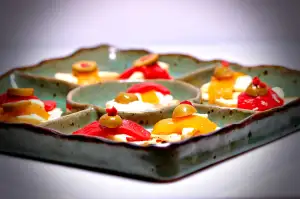Master the Art of Making Risotto: A Step-by-Step Guide to Perfecting the Creamy Italian Delicacy

Risotto is a classic Italian dish that has gained popularity worldwide for its rich, creamy texture and delicious flavors. Originating in Northern Italy, risotto is made with Arborio or Carnaroli rice, which has a high starch content that gives the dish its signature creaminess. Unlike other rice dishes, risotto is cooked slowly and requires constant stirring to release the starches and create a velvety consistency.
The beauty of risotto lies in its versatility. It can be prepared with various ingredients such as vegetables, seafood, meat, or even cheese, allowing for endless flavor combinations. Whether you prefer a simple mushroom risotto or a decadent lobster risotto, this dish offers something for everyone.
While making risotto may seem intimidating at first, with the right technique and ingredients, anyone can master this Italian delicacy. In this step-by-step guide, we will walk you through the process of making perfect risotto from start to finish. So put on your apron and get ready to embark on a culinary journey filled with creamy goodness!
Ingredients for Risotto
To make a delicious risotto, you will need the following ingredients:
1. Arborio Rice: This short-grain Italian rice is essential for achieving the creamy texture of risotto. Its high starch content helps create a velvety consistency.
2. Stock: A flavorful stock forms the base of any good risotto. You can use vegetable, chicken, or beef stock depending on your preference. Homemade stock is ideal, but store-bought options work well too.
3. Aromatics: Onions and garlic are commonly used as aromatics in risotto. They add depth and flavor to the dish.
4. Wine: A dry white wine like Chardonnay or Sauvignon Blanc adds acidity and complexity to the risotto.
5. Butter: Butter enriches the risotto, giving it a luscious mouthfeel.
6. Parmesan Cheese: The nutty and salty flavors of Parmesan cheese enhance the taste of risotto and contribute to its creamy texture.
7. Seasonings: Salt and freshly ground black pepper are essential for seasoning the dish to taste.
These basic ingredients form the foundation of a classic risotto recipe. However, feel free to experiment with additional ingredients such as mushrooms, seafood, vegetables, or herbs to create unique variations of this Italian delicacy.
Preparing the Stock
A flavorful stock is the foundation of a delicious risotto. Traditional Italian recipes often call for homemade chicken or vegetable stock, but store-bought options work well too. To prepare your own stock, start by simmering chicken bones or vegetable scraps with aromatic ingredients like onions, carrots, celery, and herbs. This slow cooking process allows the flavors to meld together and create a rich base for your risotto.
For a basic chicken stock, combine chicken bones or carcass with water in a large pot. Add roughly chopped onions, carrots, celery stalks, garlic cloves, and a bouquet garni (a bundle of fresh herbs tied together). Bring the mixture to a boil and then reduce the heat to low. Simmer gently for at least 2 hours, skimming off any impurities that rise to the surface.
Vegetable stock follows a similar process but omits the chicken bones. Instead, use a combination of vegetables like onions, carrots, celery, leeks, mushrooms, and herbs such as thyme and parsley. Simmer these ingredients in water for about an hour to extract their flavors.
If you're short on time or prefer convenience without compromising taste, store-bought stocks are readily available in most grocery stores. Look for low-sodium options to have better control over the seasoning of your risotto.
Once your stock is ready or you have purchased it from the store, strain it through a fine-mesh sieve to remove any solids. You now have a flavorful liquid ready to be incorporated into your risotto during the cooking process.
Sautéing the Aromatics
The key to achieving rich and flavorful risotto lies in sautéing the aromatics. Aromatics are ingredients like onions, garlic, and shallots that add depth and fragrance to the dish. Begin by finely chopping one medium-sized onion and a couple of cloves of garlic.
In a large, heavy-bottomed saucepan or skillet, heat a tablespoon of olive oil over medium heat. Add the chopped onion and garlic to the pan and sauté them until they become translucent and fragrant, usually around 2-3 minutes.
To enhance the flavors further, you can also add some finely chopped shallots or leeks at this stage. These ingredients will infuse your risotto with a delicate sweetness.
Make sure to stir the aromatics constantly while sautéing to prevent them from burning. The gentle cooking process allows their flavors to develop without overpowering the dish.
Once your aromatics have softened and released their enticing scents, it's time to move on to the next step: adding the rice.
Adding the Rice
Once your aromatics are nicely sautéed, it's time to add the star ingredient: the rice. Arborio or Carnaroli rice are the preferred varieties for making risotto due to their high starch content, which creates that signature creamy texture.
Measure out 1 cup of rice per serving and add it to the pan with the aromatics. Stir it gently to coat each grain with the flavorful oils and allow it to toast slightly for a minute or two. This step helps to enhance the nutty flavor of the rice.
Make sure every grain is coated before proceeding to the next step. The rice should become translucent around the edges but still have a white center.
Remember not to rinse the rice before cooking as you want to retain its starch, which will help create that velvety consistency in your risotto.
Now that you've added the rice, you're one step closer to a delicious bowl of risotto. It's time to move on to cooking this Italian delicacy!
Cooking the Risotto
Once you have sautéed the aromatics and added the rice, it's time to start cooking the risotto. This step is crucial in achieving that perfect creamy texture.
1. Heat: Begin by turning the heat to medium-high and let the rice cook for a couple of minutes. This will help toast the grains slightly, enhancing their nutty flavor.
2. Wine: Next, add a splash of white wine to deglaze the pan. Stir continuously until the wine has evaporated, which should take about a minute or so.
3. Simmer: Reduce the heat to medium-low and start incorporating the stock into the rice mixture. Add about 1/2 cup of hot stock at a time, stirring gently but consistently until most of it has been absorbed before adding more.
4. Timing: The cooking process usually takes around 20-25 minutes from this point on, but keep in mind that it can vary depending on factors such as your stovetop and preferred consistency.
5. Testing: To check if your risotto is done, taste a grain of rice. It should be cooked through but still have a slight bite (al dente). If it's too firm, continue adding stock and cooking for a few more minutes.
Remember to keep stirring throughout this process to release starches from the rice and create that signature creaminess.
By following these steps, you'll be able to achieve a perfectly cooked risotto with just the right amount of tenderness and creaminess.
Incorporating the Stock
Once the rice has been sautéed and toasted, it's time to start incorporating the stock. This is a crucial step in making risotto as it helps to develop the creamy texture and rich flavor of the dish.
To begin, have your simmering stock nearby and ready to use. Using a ladle, add a small amount of hot stock to the pan with the rice. Stir gently but continuously until most of the liquid has been absorbed.
Continue adding stock gradually, about 1/2 cup at a time, stirring constantly and allowing each addition to be absorbed before adding more. The key here is patience - rushing this process can result in undercooked or unevenly cooked rice.
As you stir, you'll notice that the rice grains release their starches into the liquid, creating a velvety consistency. This slow incorporation of stock allows for maximum absorption and ensures that each grain cooks evenly.
Be mindful not to add too much stock at once or let the pan dry out completely between additions. It's important to maintain a gentle simmer throughout cooking to properly cook the rice without overcooking it.
The total cooking time will vary depending on the type of rice used, but typically takes around 20-30 minutes. Taste test along the way to determine when the risotto is al dente - tender with a slight bite but not mushy.
Remember that risotto should have a slightly loose consistency, so don't worry if it seems too wet during cooking. It will continue to thicken as it sits off heat before serving.
With practice and attention to detail, you'll soon master the art of incorporating stock into risotto, resulting in a luscious and perfectly cooked dish every time.
Adding the Final Touches
Once the risotto is cooked to perfection, it's time to add those final touches that will take your dish to the next level. Here are a few ideas to enhance the flavor and presentation of your risotto:
1. Cheese: A classic addition to risotto is grated Parmesan cheese. Stir in a generous amount of freshly grated Parmesan just before serving to add a rich and creamy texture.
2. Butter: For an extra velvety finish, stir in a knob of butter right at the end. The butter will melt into the risotto, giving it a glossy sheen and adding another layer of richness.
3. Fresh Herbs: Sprinkle some finely chopped fresh herbs over the top of your risotto for a burst of freshness and color. Popular choices include parsley, basil, or chives.
4. Lemon Zest: Brighten up the flavors by adding a touch of lemon zest. Grate some lemon zest over the risotto just before serving to add a subtle citrusy aroma.
5. Seasoning: Taste your risotto and adjust the seasoning if needed. Add salt and pepper according to your preference, keeping in mind that Parmesan cheese already adds some saltiness.
Remember, these final touches should complement the flavors already present in your risotto rather than overpower them. Be mindful not to overload with too many ingredients as simplicity often shines through in Italian cuisine.
With these finishing touches, you're now ready to serve up your perfectly creamy and flavorful risotto!
Serving and Enjoying the Risotto
Once your risotto is cooked to perfection, it's time to serve and enjoy this creamy Italian delicacy. Here are some tips on how to present and savor your risotto:
1. Serve immediately: Risotto is best enjoyed right after cooking while it's still hot and creamy. Avoid letting it sit for too long as it can become sticky or lose its texture.
2. Plate with finesse: Use a wide, shallow bowl or plate to showcase the risotto's creamy consistency. Gently spoon the risotto onto the plate, spreading it out evenly.
3. Garnish creatively: Add a final touch of flavor and visual appeal by garnishing your risotto with fresh herbs like parsley or basil. You can also sprinkle some grated Parmesan cheese on top for an extra burst of richness.
4. Pair with complementary flavors: Risotto pairs well with a variety of ingredients and flavors. Consider serving it alongside grilled vegetables, roasted chicken, or seared seafood to create a balanced and satisfying meal.
5. Enjoy mindfully: Take the time to savor each bite of your homemade risotto. Appreciate the creamy texture, the rich flavors, and the comforting warmth that this dish brings.
Remember, making risotto is an art that requires patience and attention to detail. With practice, you'll be able to master this classic Italian dish and impress your guests with your culinary skills. So go ahead, serve up a bowl of deliciousness and indulge in the pleasure of homemade risotto!
Tips and Variations for Making Risotto
1. Use the right rice: Arborio, Carnaroli, or Vialone Nano are the preferred types of rice for making risotto due to their high starch content, which gives risotto its creamy texture.
2. Toast the rice: Before adding the liquid, sauté the rice in butter or olive oil for a few minutes. This helps to seal in the flavors and gives the risotto a nutty taste.
3. Keep stirring: Stirring is crucial for achieving a creamy consistency. It helps release starch from the rice and prevents it from sticking to the bottom of the pan.
4. Gradually add stock: Add warm stock gradually, about 1/2 cup at a time, allowing each addition to be absorbed before adding more. This ensures even cooking and allows the rice to absorb flavors properly.
5. Experiment with flavors: Risotto is versatile and can be customized with various ingredients like mushrooms, seafood, vegetables, or cheese. Don't be afraid to get creative and try different combinations.
6. Add wine for depth: Adding a splash of white wine after sautéing the aromatics adds depth of flavor to your risotto. The alcohol evaporates during cooking, leaving behind a rich taste.
7. Finish with butter and cheese: Just before serving, stir in a knob of butter and grated Parmesan cheese to enhance creaminess and add richness to your risotto.
8. Serve immediately: Risotto is best enjoyed right after cooking while it's still hot and creamy. It tends to thicken as it cools down, so serve promptly for optimal texture.
9. Leftover risotto? No problem! Turn it into arancini (fried rice balls) by shaping cold risotto into balls, stuffing them with cheese or other fillings, coating them in breadcrumbs, and frying until golden brown.
10. Have fun and experiment: Don't be afraid to try new flavors, ingredients, and techniques. Risotto is a versatile dish that allows for endless creativity in the kitchen. Enjoy the process and make it your own!
Published: 09. 02. 2024
Category: Recipes



